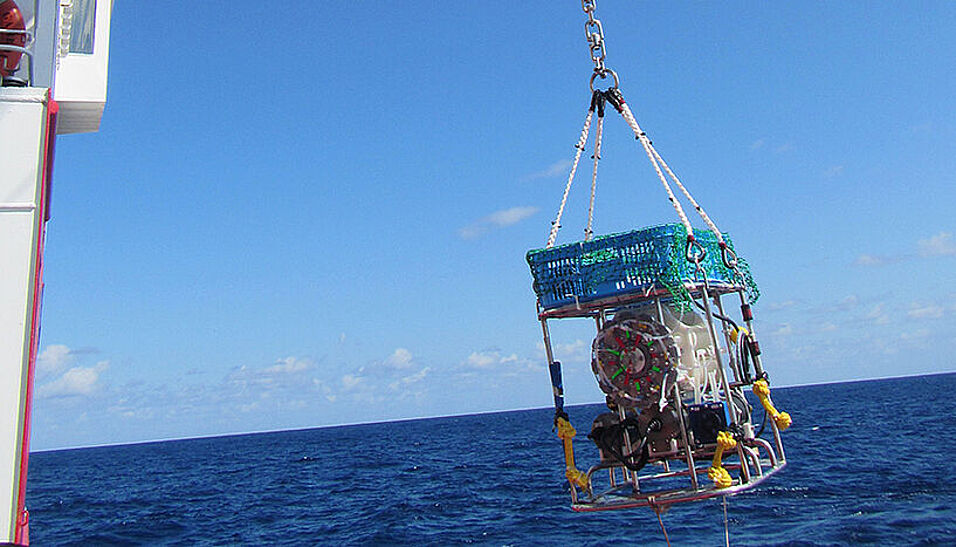An international team led by Gerhard J. Herndl of the University of Vienna has discovered that less organic carbon is consumed in the deep sea than previously assumed. This is because the deep-sea microorganisms on the seafloor, or below 1,000 meters depth, are exposed to such high water pressure that they are strongly inhibited in their metabolic production and therefore consume less organic material as food than previously thought. When their activity is measured aboard research vessels - under surface pressure conditions - as is commonly done, they show up to a hundred times higher activity than under deep-sea pressure conditions, which has so far skewed research results. These new findings have major implications for our understanding of the carbon cycle of the deep sea and the oceans in general, and were published in the prestigious journal Nature Geoscience.
The deep sea, the area of 200 m depth and deeper as well as the seafloor itself, is the habitat with the largest surface volume on our planet, but also the area that is explored the least. The deep sea below 1,000 m depth is generally a cold habitat with water temperatures between 0-4°C. Additionally, an enormous water pressure weighs on the organisms living there. The deep-sea water masses below 1,000 m depth flow through the three large oceanic basins, the Atlantic, Pacific and Indian Oceans, with one complete round about every hundred years. This is known as part of the "thermohaline circulation". The circulation ensures that cold water is transported from the poles to the tropics and that warm surface water travels from the tropics to the poles and is fundamentally important for our climate.
Decomposition of organic material in the ocean
The sunlit surface layers of the ocean produce organic material that, which serves as the basis of the oceanic food web. While most of this material is broken down into carbon dioxide and inorganic nutrients in surface waters, about 10 to 20 percent of the organic material sinks to the ocean depths and acts as a food source for deep-sea communities. The breakdwn of organic material there is primarily accomplished by a diverse microbial community whose composition and metabolism change with increasing depth. Bacteria are the most important group of deep-sea organisms that convert the particulate rain of organic matter from the surface layers of the ocean back into inorganic compounds.
In the current study, a team led by Gerhard J. Herndl of the University of Vienna, together with colleagues from Spain and Japan, investigated the metabolism of the microbial community in the Earth's three major ocean basins under the pressure conditions at the respective depths and compared this activity with that measured on board the research vessel under surface pressure conditions. They found that with increasing depth, the difference in activity of the bacterial community decreases "At a depth of 4,000 m, the measured activity is only about one-third of the activity we measured on board the research vessels," said Gerhard J. Herndl, the initiator of the study.
Not all bacteria are equally sensitive to pressure
The scientists also investigated whether the entire bacterial community reacts equally under high pressure, or whether this only affects parts of the bacterial community. Using single-cell analyses, the team found that about 85% of the deep-sea bacterial community is insensitive to changes in water pressure, and 5% of bacteria even require the high-water pressure of the deep sea to grow. Only about 10% of the deep-sea bacterial community responds to being brought up from the deep sea, i.e., pressure reduction, with activity up to a hundred times higher than in the deep sea. "This small part of the bacterial community, which apparently suffers from the pressure conditions of the deep sea, apparently originated in surface waters and was transported to the deep sea with sinking particles and shows little activity. However, when the bacteria are brought back to the surface, they immediately respond with very high growth rates," says Herndl.
What do these results imply for the carbon cycle in the deep sea?
Overall, the researchers' findings show that the organic carbon demand of deep-sea organisms is much lower than previously assumed. This means that the previously measured discrepancy between the high organic carbon demand of deep-sea bacterial communities and at the same time a low carbon influx into the deep sea does not work in this way. "This discrepancy between consumption and delivery suggests that research has not considered or properly measured several parameters. Our study shows that the majority of bacteria are relatively insensitive to pressure. However, it is surprising that only 10 percent of the bacterial community can have such a large impact on overall bacterial activity, meaning previous measurements have been skewed”, says Chie Amano, lead author of the study.
The study on the influence of hydrostatic pressure on deep-sea microorganisms was funded by the Austrian Science Fund (FWF) and the European Research Council (ERC), among others.
Original publication:
Chie Amano, Eva Sintes, Thomas Reinthaler, Julia Stefanschitz, Murat Kisadur, Motoo Utsumi, Gerhard J. Herndl. Limited carbon cycling due to high pressure effects on the deep sea microbiome. Nature Geoscience

